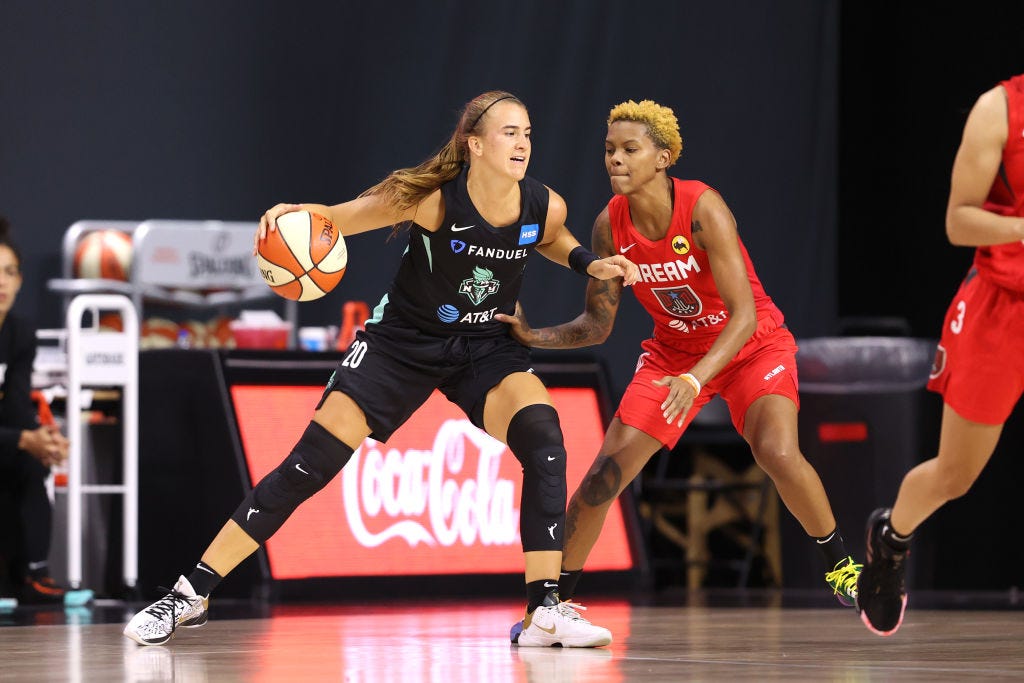How The NCAA's "Free Year" Is Affecting The WNBA Draft
WNBA teams will change their draft preparation for 2021 due to the NCAA's new eligibility rules.
By the time that Cathy Englebert called out Sabrina Ionescu's name as the first pick of the 2020 WNBA Draft, the WNBA community had known Ionescu would be the top pick for close to a year. The New York Liberty certainly did their homework, but they also likely had her pegged for the first overall pick for months. New York has the first overall pick again in 2021 but probably won’t know who the top pick will be until right before the draft, and not just because there’s no Sabrina Ionescu in this draft.
“The biggest challenge is just not really knowing who's going to be there,” said Liberty GM Jonathan Kolb in a press conference after the draft lottery. “It's such a unique feeling we picked number one, right? Because usually, when you pick number one, you know who is going to be available.”
The uncertainty stems from the NCAA’s new eligibility rules. In response to COVID-19, the NCAA granted every student-athlete an extra year of eligibility and an extra year to complete that eligibility. Players will now have six years to complete five seasons of eligibility rather than the normal five years for four seasons. While the decision represents a bright spot for the NCAA, the “free year” will greatly complicate the WNBA Draft process.
From a league-wide perspective, the WNBA will find out how attractive the league is to college players. Every single player drafted in 2021 will have to pick the WNBA draft over another year of college basketball. The decision may not be difficult for top prospects like Arizona’sAari McDonald or Rennia Davis of Tennessee because first-round picks rarely get cut and make a decent salary on their rookie contract. Prospects on the fringe of the first round or further down the draft face a tougher decision. They may want to return to school to improve their draft stock, finish up a degree, or try to win a title with their teammates. Former Maryland star Christy Winters-Scott talked about how tough that decision would have been for her on a recent episode of Courtside on the Her Hoop Stats Podcast Network.
Atlanta Dream head coach Nikki Collen pointed to Mikayla Pivec, the Dream’s third-round pick in 2020, as a player who would have probably gone back to school if given a “free year.” But Collen is hypothesizing that most top seniors would decide to make the jump to the pros.
“These players know there's a finite amount of time to make money playing sports,” said Collen after getting the third pick in the lottery. “I'm as big a fan of college athletics as anyone having been in it many, many years, and certainly see value in players having extra eligibility. I also think that a lot of times players, you know, hit that point where it's, it's time to say what's next.”
While coaches and general managers have educated guesses about which players will declare, they still need to prepare differently for this draft. For starters, teams will have to widen the draft pool to prepare for the possibility of players returning to school. All four decision-makers that participated in the draft lottery —Kolb, Collen, Dallas Wings President Greg Bibb and Indiana Fever head coach Marianne Stanley— noted that their draft preparation would likely include more players than in previous years.
“We will widen the pool absolutely, and we're gonna have every scenario planned out. This is fun, guys,” said Kolb. “We're gonna scout more, we'll watch more hours of film, we'll have more phone conversations, zoom calls to these players. But that's how we'll get ready for it and we're excited to get going.”
This is all speculative at the moment. Coach Stanley made it clear that there are a lot of questions to answer between now and the draft in April. In a typical season, college players with remaining eligibility must renounce their eligibility at least 10 days before the draft or within 24 hours after their final college game, if it takes place within the 10-day window.
The ten-day rule is convoluted in and of itself. But there’s an extra layer of confusion in 2020 for every college player with remaining eligibility. Teams still need guidance from the WNBA on how the rule will work this season.
Of course, “free year” challenges are compounded with other pandemic-related complications. Teams aren’t able to go see players in person for the most part. While numerous video and analytics sources can help mitigate the problem, organizations still rely on watching games in-person to measure a player’s character, communication skills and traits that don’t show up on film, like how they put spin on passes. Coach Collen mentioned not seeing players in practice as a major hindrance because practice is where you see how committed players are to improving their game.
The limitations on in-person viewership may change if COVID-19 vaccines are administered faster than anticipated. It’s conceivable that the NCAA tournament could allow scouts in March, albeit seemingly very unlikely. For now, teams need to use all of the tools at their disposal and prepare for any possibility.
“Coaches are resourceful people and we’ll all find a way to get the job done to evaluate players and to make good decisions,” said Coach Stanley in response to Howard Megdal of The Next.
We will have to wait for April to see exactly how all of this will play out. But, we can confidently say that the NCAA’s “free year” rule will make teams work harder to accomplish what they have in previous years.




